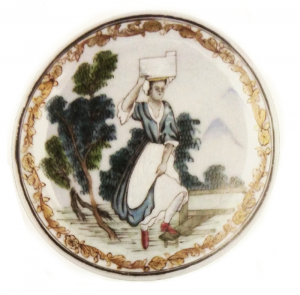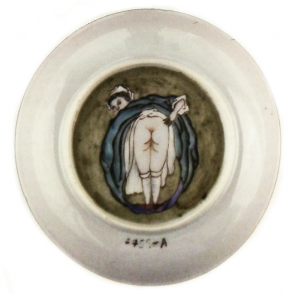Object Label
China, Saucer, c.1770-96, enamelled porcelain
Displayed here is a pretty saucer, adorned a willow pattern of sorts, with a slight western twist, much like rococo(Late Baroque) style framing, of gold leaves that encases a milk maid, in colour, gathering the hem of her dress as she steps over a stile. The scenery is remnant pleasing landscapes in china ware, but the European figure, exemplifies its intended audience. The imagery is suggestive enough, allowing a view of the maiden’s underskirt, fully revealed through her own doing but there is more. Viewers are in for a treat as they flip over the plate for a full view of the maiden’s bare buttocks, teasingly welcoming the alleged’s eyes.The subject matter is voyeuristic in nature, clearly allowing the male gaze to take place and in light humor of the hidden “behind” that lies in the back of our minds.
Catalogue
China, Saucer, c.1770-96, enamelled porcelain
18th century women in Britain, were all for porcelains wares and the demand of such goods certainly pushed the market as well as meaning of these objects, without a doubt relating to the feminine, in both fragile beauty and perhaps, being a useless display, similar to the position of the female in a patriarchal society.
The grandiose yet excessive style of chinoiserie also then, reflected the wants and needs of the consumers or housewives then, which took little heed to classic styles and merely grabbing onto certain motifs, such as the willow pattern which was inspired by chinaware imports in the early 1800s.
Interestingly, the plate itself, bridges the very idea of women as porcelain, the very thing which they indulged in, reflects back upon themselves. William Wycherley’s 1675 play The Country Wife had his character, Mr Horner making love to Lady Fidget under the guise of showing her “his china collection.” The notion of self-gratifying need for both erotic and exotic sums the conception of hoarding collections of chinoserie along with it’s sexual allusion, where consumerism and excessive desire ran rampant.
Displayed here is a pretty saucer, adorned a willow pattern of sorts, with a slight western twist, much like rococo(Late Baroque) style framing, of gold leaves that encases a milk maid, in colour, gathering the hem of her dress as she steps over a stile. The scenery is remnant pleasing landscapes in china ware, but the European figure, exemplifies its intended audience. The imagery is suggestive enough, allowing a view of the maiden’s underskirt, fully revealed through her own doing but there is more. Viewers are in for a treat as they flip over the plate for a full view of the maiden’s bare buttocks, teasingly welcoming the alleged’s eyes.The subject matter is voyeuristic in nature, clearly allowing the male gaze to take place and in light humor of the hidden “behind” that lies in the back of our minds.
Such objects were likely passed around among intimate group of friends or even lovers and contributed to the associations of chinoiserie with erotic fantasy, humour and promiscuity.
Sloboda, S. (2014) Chinoiserie : commerce and critical ornament in eighteenth-century Britain Manchester, New Hampshire: Manchester University Press

